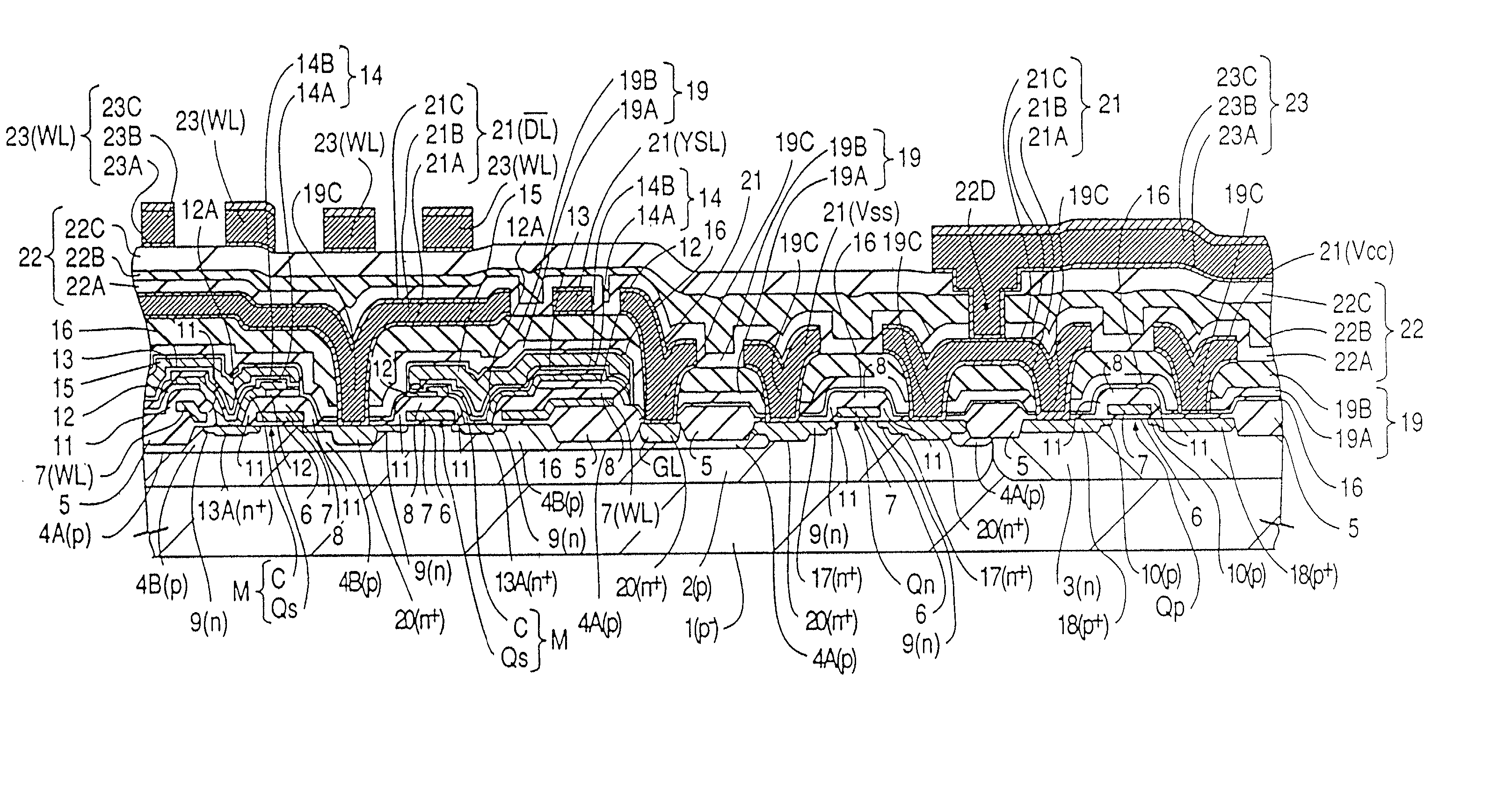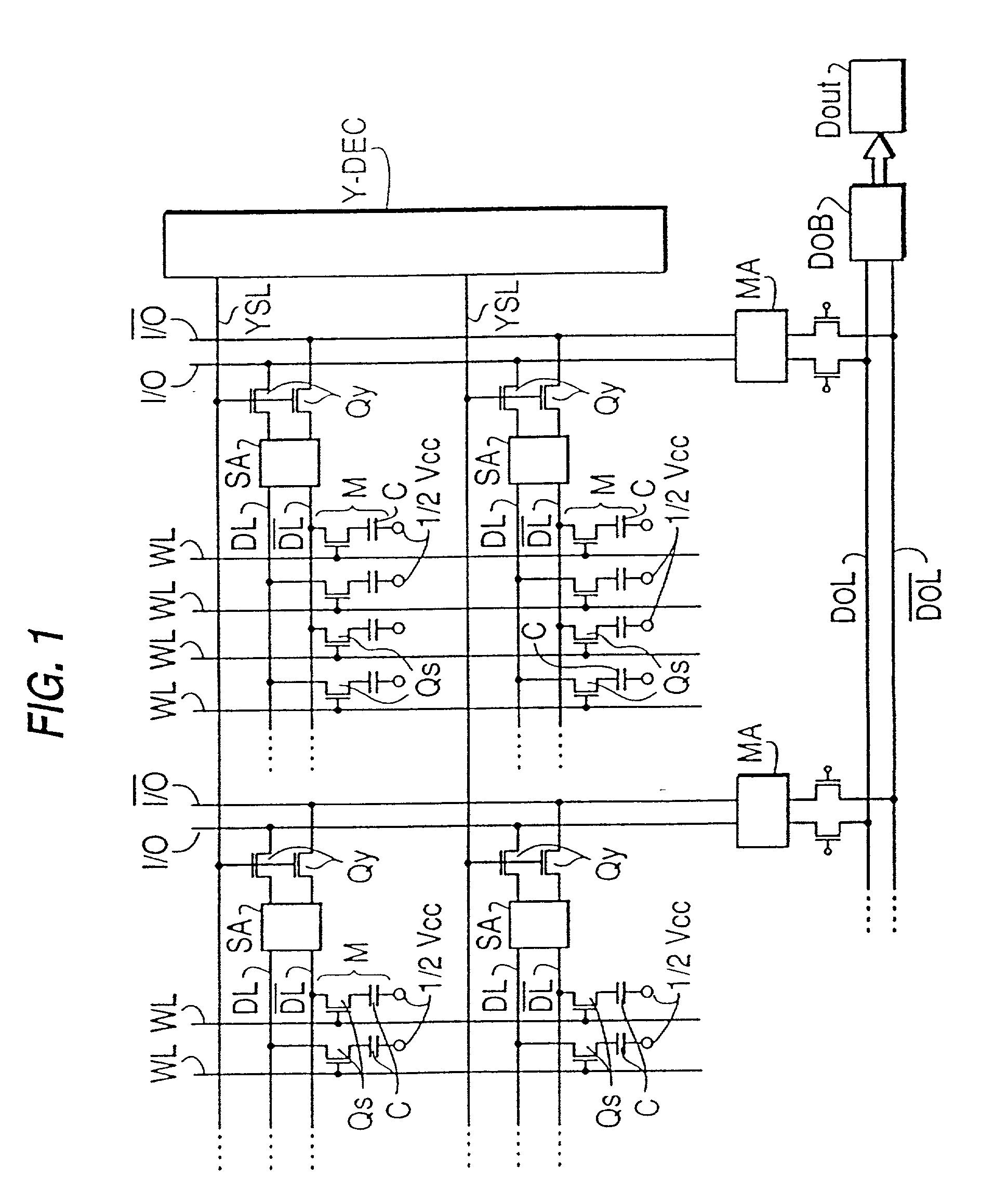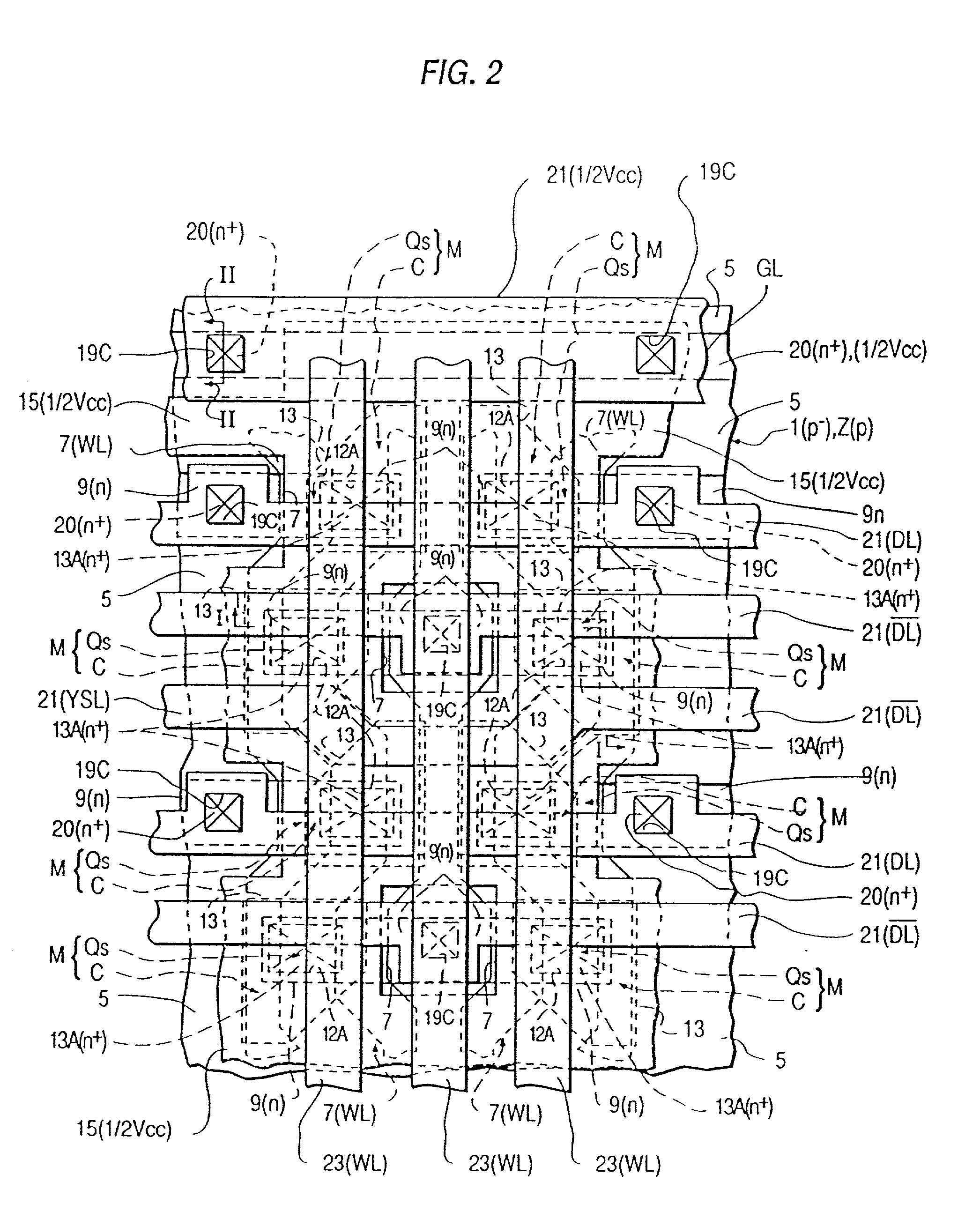[0018] The introduction of the P-type impurity for forming the potential
barrier layer increases the impurity concentration of the aforementioned
channel stopper region in the
peripheral region of the
memory cell. This increase in turn drops the PN junction
breakdown strength between one semiconductor region (forming part of the information storing capacitor element, that is, a storage node) of the MISFET of a
memory cell and the
channel stopper region. This drop in the junction
breakdown strength causes the electric charges stored in the stacked capacitor element to leak, thereby degrading its information holding characteristics, so that the frequency of refreshing such information is increased. As a result, the reading and writing rates of the DRAM increases, thus decreasing the speed of the DRAM. Moreover, such DRAM, having such potential
barrier layer, requires an increased number of fabrication steps, due to the addition of the step of forming the aforementioned potential barrier layer.
[0020] D. In connection with a fourth aspect of the present invention, the inventors have found the following problems arising upon increasing the integration density of the DRAM. Thus, the memory
cell is required to have an isolating space between the first
electrode layer of the stacked capacitor element and an intermediate conducting layer which connects a data line to a semiconductor region of the memory
cell selecting MISFET. Such isolating space causes a decrease in the area of the first electrode layer of the stacked capacitor element, and accordingly decreases the amount of storage of electrical charges which can be achieved in the stacked capacitor element. Moreover, when the second electrode layer of the stacked capacitor element is to be patterned, the intermediate conducting layer uses a
dielectric film formed thereover as an
etching stopper; however, since this dielectric film is very thin, the intermediate conducting layer can be damaged or broken as a result of over-
etching in patterning the second electrode layer. This causes a poor connection between the data line and the other semiconductor region of the MISFET.
[0023] On the other hand, where the dielectric film of the stacked capacitor element is used as an
etching stopper when the second electrode layer is patterned, and when patterning of the second electrode layer is accomplished by
plasma etching, for example, the further problem arises that the dielectric film left uncovered by the second electrode layer is charged up with electric charges during patterning of the second electrode layer, so that its
dielectric breakdown strength decreases; this deteriorates the reliability of the DRAM. Accordingly, according to this fourth aspect of the present invention, it is desired to provide a technique wherein the integration density of the DRAM can be increased without deteriorating the reliability of the DRAM, while still satisfactorily providing the stacked capacitor element and data line connection to the other semiconductor region of the memory
cell selecting MISFET.
[0025] F. In connection with a sixth aspect of the present invention, the inventors have discovered that, in connection with aluminum wiring (such as the data line) used in, e.g., a DRAM, shape defect and disconnection occur frequently due to
electrolytic corrosion. As a result of analysis of the aluminum wiring, the inventors believe that such
electrolytic corrosion occurs during a wet treatment after forming such wiring. Specifically, the aluminum wiring to which the element for reducing migration is added is formed by
anisotropic etching, such as
reactive ion etching (RIE) using a
photoresist film as an etching
mask. After this
anisotropic etching step, the aluminum wiring is subjected to
water washing and a cleaning treatment, and to a wet treatment, using a liquid, to remove the
photoresist film utilized as an etching
mask during the
anisotropic etching. During this wet treatment, a battery (galvanic) reaction occurs with the base (aluminum) of the aluminum wiring serving as an
anode and an
intermetallic compound formed by aluminum and the element for reducing
electromigration added to the wiring, as described above, serving as a
cathode. This galvanic reaction corrodes the base of the wiring around the
intermetallic compound as a
nucleus, with shape defects or disconnection of the aluminum wiring resulting from this galvanic reaction; such result lowers the electrical reliability of the wiring used in the DRAM.
[0026] In order to improve electrical reliability of the aluminum wiring resulting from the galvanic reaction described above, the inventors of the present invention dispose a protective film on the aluminum wiring to protect it from the liquid used in the wet treatment. A refractory metal film or a refractory
metal silicide film having resistance to wet treatment, and high reliability in a semiconductor fabrication process, is used as the protective film. This protective film is formed by first depositing an aluminum film by
sputtering, by use of a sputtering apparatus, and then depositing the protective film by use of another sputtering apparatus, or a CVD apparatus. However, the inventors have found that an aluminum
oxide film is instantaneously formed on the aluminum film, while the formed structure is transferred between, for example, the sputtering apparatus for depositing the aluminum film and another sputtering apparatus, or a CVD apparatus, for forming the protective film. This aluminum oxide functions as an etching stopper when the aluminum film is patterned and results in the problem that the aluminum film cannot be etched. Thus, according to this sixth aspect of the present invention, there is a desire to provide a structure of aluminum film and protective film, without such aluminum oxide film.
[0027] G. In connection with a seventh aspect of the present invention, and in order to provide DRAMs having large integration density, applicants have found that when MoSi.sub.2 is utilized as the protective film for protecting the aluminum wiring from a liquid used for wet treatment to remove the
photoresist mask utilized for anisotropic etching to form the wiring, with an upper layer aluminum wiring being provided on the MoSi.sub.2 (for example, such MoSi.sub.2 being provided in a through-hole in an inter-layer insulating film to provide electrical
conductivity between upper and lower aluminum wiring
layers), the
contact resistance value increases abnormally at the interface portion between the MoSi.sub.2 and the upper aluminum wiring. As a result of analysis, the inventors have found that aluminum particles of the lower layer aluminum wiring precipitate at the interface through MoSi.sub.2 and an aluminum oxide is formed at the interface. The increase in
contact resistance value between the lower and upper layer aluminum wirings reduce the yield of the through-holes.
 Login to View More
Login to View More  Login to View More
Login to View More 


